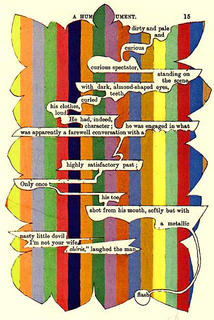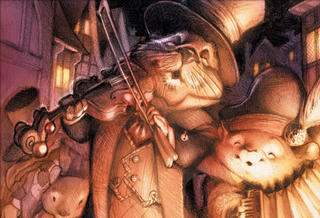
Johannes Hevelius in Machina coelestis Volume I, 1673. He is a founder of lunar topography. He used this device to project an image of the moon which he proceeded to map.
"The Würzburg monk Johannes Zahn is obsessed with optical phenomena connected with vision and the use of lenses." 1685
Smelting furnace design 1806.
"For a time the Italian Tuccaro is gymnastics instructor to the young King of France, Charles IX" 1599
Image from Alexander Doyle's 1719 book, Voltagier-Kunst.
Jacques Besson(i), Il Theatro de gl' Instrumenti e Machine con una brieve dichiaration di tutte le figure di F. Beroaldo. 1582.
Andreas Cellarius 'The Battering Ram in Combat' from Architectura Militaris, 1645.
This collaborative Swedish site (in ~english) is the best digital exhibit I've seen since...well, let's just say it is brilliant and comprehensive and larger than expected. Kungliga bibloteket, Stockholms universitetsbibliotek, Umeå universitet, Uppsala universitetsbibliotek, and 8 other organisations have combined to present 'Tankens bilder - Images of Thought'.
Basically it tracks intellectual thought since the dawn of illustrative printing, covering anatomy, natural science, astronomy, engineering, warcraft, artistic perspective (and more) and with a particular devotion to the development of printing in relation to illustrations. It all stems from scans they present from rare books. This is truly a fantastic site for a book image junkie like myself. Note: the sidebar links will take you to one large section of this site; the icons on the main page will take you to another.
Saturday, October 22, 2005
Images of Thought
The Making of Chocolate
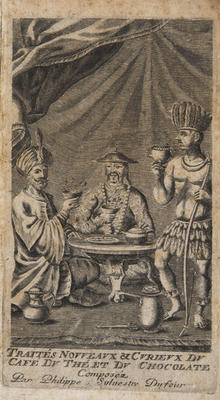
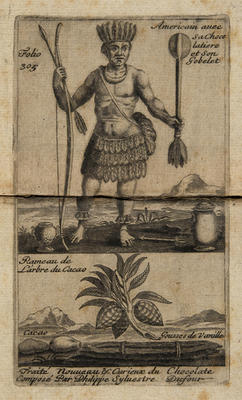
It was no doubt a shrewd editorial decision that saw the inclusion of an engraving of three exotic men in Lyon pharamcist Philippe Sylvestre Dufour's 1671 Traitez Nouveaux & Curieux du Café, du Thé et du Chocolate. Ouvrage également necessaire aux Medecins , & à tous ceux qui aiment leur santé. (The manner of Making Coffee, Tea & Chocolate)
The three men (above) represent the middle east, asia and the new worlds and are depicted drinking coffee, tea and chocolate, which didn't become particularly fashionable in europe until the latter part of the 17th century, due in no little part to Dufour's popular book. In it he describes methods for making each beverage and debates the medicinal benefits and drawbacks of the caffeine drinks; though he lifted much of the material from other sources it seems.
This was not the first that had been heard of chocolate or Theobroma cacao (food of the Gods) in europe. In the middle of the 16th century, two Aztec Indians produced the seminal botanical and herbal Badianus manuscript or Codex Barberini. Their work was sent to King Charles V of Spain and it was reported that the Aztec King Montezuma also drank chocolate before visiting his harem.
- Dufour's book (the 1688 2nd edition) is online at Biblioteca Digital de Obras Raras et Especiais in Brazil (click on the book cover) but there is only one other engraving that I saw, with little in the way of artistic merit.
- Caffeine dependencies in the early modern world.
- The Badianus Manuscript pictures (it's available in 12 volumes at amazon for $500)
- Digging up fascinating facts about chocolate.
- Chocolate Therapies - note the alleged origin of the word 'chocolate' below the Dufour engraving - not sure if I believe that one or not.
- Coffee, chocolate, tea at Kings College London.
- Theobroma cacao Linné.
- Chocolate link lust.
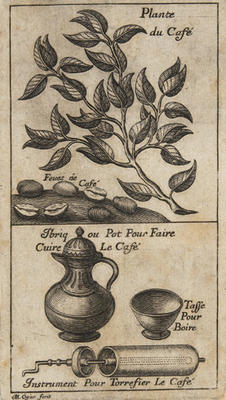
Body Mind Spirit
 An elaboration upon the William Harvey analogy of a human being to a house structure in Tobias Coh(e)n's 1708 Ma´aseh Tobiyyah. I searched in vain for a full copy of this intriguing book, but there's another image at the Jewish Virtual Library. It is said to be a mini-encyclopedia on theology, anatomy, hygeine, astronomy and botany.
An elaboration upon the William Harvey analogy of a human being to a house structure in Tobias Coh(e)n's 1708 Ma´aseh Tobiyyah. I searched in vain for a full copy of this intriguing book, but there's another image at the Jewish Virtual Library. It is said to be a mini-encyclopedia on theology, anatomy, hygeine, astronomy and botany.[The image detail here comes from the Library of Congress - highest resolution].
 From the Miao-tzu albums of late 17th century China -
From the Miao-tzu albums of late 17th century China -it was thought important to empathize with all persons within
the border. Black Mia minority men playing mouth pipes.
Holiday Snark
“Leave him here to his fate—it is getting so late!”
The Bellman exclaimed in a fright.
“We have lost half the day. Any further delay,
And we sha’nt catch a Snark before night!”


These images are the original caricaturish illustrations by Henry Holiday that accompanied Lewis Carroll's 1876 comic poem, The Hunting of the Snark (An Agony in Eight Fits).
All 9 original Holiday illustrations are displayed, together with a reproduction of the text of The Hunting of the Snark at the University of Adelaide Library.
UPDATE (Feb. 2009): See this interesting pdf - mentioned by Goetz in a comment below - that provides some compelling evidence about the historical illustration origins/inspiration for Holiday's drawings in 'The Hunting of the Snark'.
Friday, October 21, 2005
Cook's Voyage to the Pacific Ocean
"From what I have said of the Natives of New Holland they may appear to some to be the most wretched people upon Earth, but in reality they are far happier than we Europeans; being wholly unacuainted not only with the superfluos but the neessary conveniences so much sought after in Europe, they are happy in not knowing the use of them. They live in a Tranquility wich is not disturb'd by the Inequality of Conditions: The Earth and sea of their own accord furnishes them with all things necessary for life, they covet not Magnificient Houses, Householdstuff etc., they live in a warm and fine climate and enjoy a very wholesome Air, so that they have very little need for Clothing and this they seem to be fully sensible of, for many to whome we gave Cloth etc. to, left it carelessly upon the Sea beach and in the woods as a thing they had no manner of use for. In short term, nor would they ever part with any thing of their own for any one article we could offer them; this in my oppinion argues that they think themselves provided with all the necessary of Life and that they have no superfluities."
James Cook in The Voyage of the Endeavour.









The National Library of Australia have 87 engraving plates on display from Captain James Cook's Voyage to the Pacific Ocean of 1784. Multiple resolution and pan/zoom options. Cook was speared and stoned to death in the Sandwich Islands (Hawaii) in February 1779.
The Dreadnought Project

 The Dreadnought Project is a "collaborative effort to model and study the ships of 1890-1920".
The Dreadnought Project is a "collaborative effort to model and study the ships of 1890-1920".
[warning - the jpeg images in 'plans' are seriously b.i.g.] (click the above images for slightly larger versions)
Thursday, October 20, 2005
Heraldic Bookplates
 "A shield with helmet, mantle and crest. Arms: quarterly; 1 and 4, azure a chevron argent between in chief two torches and in base a wing argent; 2 and 3, counterquartered, 1 and 4 or a fess chequy argent and azure within a tressure flory counterflory, 2 and 3 argent a savage shooting an arrow from a bow. Crest: an arm embowed, holding a torch, between two wings elevated and displayed."
"A shield with helmet, mantle and crest. Arms: quarterly; 1 and 4, azure a chevron argent between in chief two torches and in base a wing argent; 2 and 3, counterquartered, 1 and 4 or a fess chequy argent and azure within a tressure flory counterflory, 2 and 3 argent a savage shooting an arrow from a bow. Crest: an arm embowed, holding a torch, between two wings elevated and displayed."
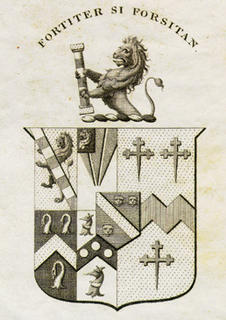 "A shield with crest. Arms: parted per pale, baron and femme; first, quarterly, 1 - or a lion rampant sable, debruised by a bend gobony argent and azure [Fausett], 2 - argent three piles meeting in base vert, on a canton sable a lion’s head erased or [Bryan], 3 - sable a chevron between three pelican’s heads erased vulning themselves or [Godfrey], 4 - argent on a chevron between three greyhound’s heads erased sable collared or as many plates [Toke]; second, or a fess dancetté between three crosses crosslet fitchy gules [Sandys]; over all an escutcheon of pretence azure, a bend between three leopard’s faces or [Nott]. Crest: a demi-lion rampant sable, holding in its paws a column gobony argent and gules, the base and capitol or."
"A shield with crest. Arms: parted per pale, baron and femme; first, quarterly, 1 - or a lion rampant sable, debruised by a bend gobony argent and azure [Fausett], 2 - argent three piles meeting in base vert, on a canton sable a lion’s head erased or [Bryan], 3 - sable a chevron between three pelican’s heads erased vulning themselves or [Godfrey], 4 - argent on a chevron between three greyhound’s heads erased sable collared or as many plates [Toke]; second, or a fess dancetté between three crosses crosslet fitchy gules [Sandys]; over all an escutcheon of pretence azure, a bend between three leopard’s faces or [Nott]. Crest: a demi-lion rampant sable, holding in its paws a column gobony argent and gules, the base and capitol or."To unlock the meanings behind these blazonings, you'll need to consult with an heraldic dictionary.
Notre Dame University is compiling a database of bookplates (ex libris) from around the world, the majority of which include the very specific, the very personal, armorial ensigns or heraldic features associated with the person for whom the bookplate was made. It has been fascinating seeing and reading about this world that I had largely not noticed previously. All 992 bookplates can be accessed from this page.

Tupinamba -v- Staden






German soldier Hans Staden sailed to Brazil on a couple of occasions and spent some years there working until his capture by a (now extinct) Tupinamba cannibal tribe from the south east of the country. He was held for a few months during which time his Spanish shipmates were executed, but he managed to escape. He published Hans Staden: The True History of His Captivity to great success in 1557.
Although simplistic, these woodcuts were the first images seen by europe of South American Indians that didn't derive from folklore or imagination. They formed the basis for emerging copper engravers such as Theodor de Bry to elaborate upon in publishing their own works about the new world.
- From descriptions elsewhere, it's a little difficult to decide whether the 180 page original german book on display at Brazil's Biblioteca Digital de Obras Raras e Especiais is the complete 2-part set of Staden's work. Click on the title page for an easy to navigate pop-up screen; higher resolution images open another screen.
- Harry J Brown at Lehigh University.
- The Athena Review.
- The film.

Wednesday, October 19, 2005
The Time of Sarum


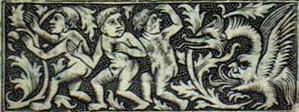
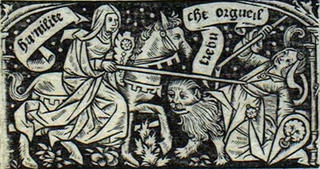
I was less impressed with the occasional illumination in this Copenhagen edition of the Hours of Sarum (ed. Anthoine Vérard, French printer. c. 1503) than I was with the large ornate woodcut border images on all 300-odd pages of this vellum manuscript. These are all border images displayed here.
- The Hours, completed for the English town of Sarum, is online at the Royal Library of Copenhagen.
- Mary Beth Winn's scholarly yet readable essay examines all aspects of the manuscript and her shorter review of Vérard's contributions to printing is also worth reading.






